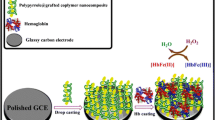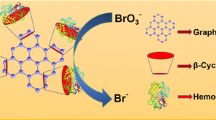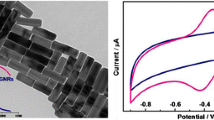Abstract
Direct electron transfer of hemoglobin modified with quantum dots (QDs) (CdS) has been performed at a normal graphite electrode. The response current is linearly dependent on the scan rate, indicating the direct electrochemistry of hemoglobin in that case is a surface-controlled electrode process. UV–vis spectra suggest that the conformation of hemoglobin modified with CdS is little different from that of hemoglobin alone, and the conformation changes reversibly in the pH range 3.0–10.0. The hemoglobin in a QD film can retain its bioactivity and the modified electrode can work as a hydrogen peroxide biosensor because of its peroxidase-like activity. This biosensor shows an excellent response to the reduction of H2O2 without the aid of an electron mediator. The catalytic current shows a linear dependence on the concentration of H2O2 in the range 5 × 10−7–3 × 10−4 M with a detection limit of 6 × 10−8 M. The response shows Michaelis–Menten behavior at higher H2O2 concentrations and the apparent Michaelis–Menten constant is estimated to be 112 μM.







Similar content being viewed by others
References
Wang CL, Mulchandani A (1995) Anal Chem 67:1109–1114
Wang J, Lin Y, Chen L (1993) Analyst 118:277–280
Kafi AKM, Yin F, Shin HK, Kwon YS (2006) Thin Solid Films 499:420–424
Hurdis EC, Romeyn H (1954) Anal Chem 26:320–325
Hanaoka S, Lin JM, Yamada M (2001) Anal Chim Acta 426:57–64
Xiao Y, Ju HX, Chen HY (1999) Anal Chim Acta 391:73–82
Tang JL, Wang BQ, Wu ZY, Han XJ, Dong SJ, Wang EK (2003) Biosens Bioelectron 18:867–872
Yang WW, Li YC, Bai Y, Sun CQ (2006) Sens Actuators B 115:42–48
Zhou Y, Li Z, Hu NF, Zeng Y, Rusling JF (2002) Langmuir 18:211–219
Fan C, Gao Q, Zhu D, Wagner G, Li G (2001) Analyst 126:1086
Fan C, Wang H, Sun S, Zhu D, Wagner G, Li G (2001) Anal Chem 71:2850–2857
Nassar AEF, Rusling JF, Nakashima N (1996) J Am Chem Soc 118:3043–3044
Huang H, Hu N, Zeng Y, Zhou G (2002) Anal Biochem 308:141–151
Chen SM, Tseng CC (2004) Electrochim Acta 49:1933–1934
Shen L, Hu NF (2005) Biomacromolecules 6:1475–1483
Sun H, Hu NF (2004) Biophys Chem 110:297–308
Dai ZH, Xu XX, Ju HX (2004) Anal Biochem 332:23–31
Topoglidis E, Cass AEG, O’Regan B, Durrant JR (2001) J Electroanal Chem 517:20–27
Zhao G, Feng JJ, Xu JJ, Chen HY (2005) Electrochem Commun 7:724–729
Liu ZM, Yang Y, Wang H, Liu YL, Shen GL, Yu RQ (2005) Sens Actuators B 106:394–400
Ren CB, Song YH, Li Z, Zhu GY (2005) Anal Bioanal Chem 381:1179–1185
Lu Q, Hu SS, Pang DW, He ZK (2005) Chem Commun 20:2584–2855
Liu SQ, Dai ZH, Chen HY, Ju HX (2004) Biosens Bioelectron 19:963–969
Wang SQ, Chen J, Liu XQ (2004) Chin J Chem 22:360–364
Wang HY, Guan R, Fan CH, Zhu DX, Li GX (2002) Sens Actuators 84:214–218
Niemeyer CM (2001) Angew Chem Int Ed Engl 40:4128–4158
Chan WCW, Maxwell DJ, Gao X., Bailey RE, Han M, Nie S (2002) Curr Opin Biotechnol 13:40–46
Liang JG, Ai XP, He ZK, Xie HY, Pang DW (2005) Mater Lett 59:2778–2781
King BC, Hawkridge FM, Hoffman BM (1992) J Am Chem Soc 114:10603–10608
Liu Y, Liu HY, Hu NF (2005) Biophys Chem 117:25–35
Bond AM (1980) Modern polarographic methods in analytical chemistry. Dekker, New York
Liu HH, Tian ZQ, Lu ZX, Zhang ZL, Zhang M, Pang DW (2004) Biosens Bioelectron 20:294–304
Sogbein OO, Simmons DA, Konermann L (2000) J Am Soc Mass Spectrom 11:312
Wang QL, Lu GX, Yang BJ (2004) Biosens Bioelectron 19:1269–1275
Ferri T, Poscia A, Santucci R (1998) Bioelectrochem Bioenerg 45:221–226
Xiao Y, Ju HX, Chen HY (2000) Anal Biochem 278:22–28
Acknowledgements
This work was supported by the National Natural Science Foundation of China (nos. 30370397, 60571042 and 20575046), Specialized Research Fund for the Doctoral Program of Higher Education (20050486026) and the Science Fund for Creative Research Groups (no. 20621502), NSFC.
Author information
Authors and Affiliations
Corresponding authors
Rights and permissions
About this article
Cite this article
Xu, Y., Liang, J., Hu, C. et al. A hydrogen peroxide biosensor based on the direct electrochemistry of hemoglobin modified with quantum dots. J Biol Inorg Chem 12, 421–427 (2007). https://doi.org/10.1007/s00775-006-0198-2
Received:
Accepted:
Published:
Issue Date:
DOI: https://doi.org/10.1007/s00775-006-0198-2




